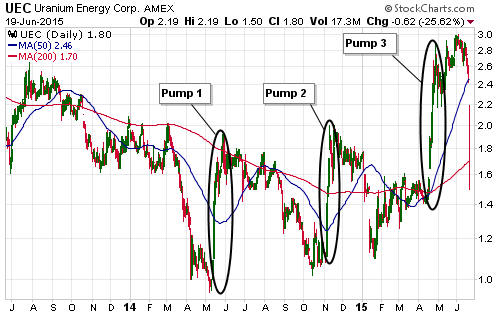Junior uranium producer Uranium Energy Corporation (UEC) has been in the news (in a bad way) over the past few days due to ‘revelations’ contained in an article posted HERE. I put inverted commas around the word revelations in the preceding sentence because there is nothing in the article that should have surprised anyone who has been following the company. I don’t follow the company closely, but I was well aware of the information that seemingly shocked the stock market late last week.
It seems that many holders of the stock were surprised to find out that UEC had essentially stopped producing uranium. They shouldn’t have been, because the company has made no secret of its scaled-back mode of operation. For example, for the past several quarters the company has reported no sales and only small increases in its uranium inventory*, indicating production on a small scale. Also, the CEO of the company sent shareholders a letter in January of this year reminding them that “Palangana [the only in-production project at this time] is operating on a small scale pending ramp-up when the price of uranium is in a viable range.”
In other words, with regard to its operational performance UEC doesn’t appear to have tried to hide anything, although the company and many of the people who recommend owning the shares have not been completely forthright (to put it politely). The reason is that if production costs were as low as claimed, UEC’s Palangana project would be solidly profitable at the current spot uranium price and very profitable at the current contract uranium price. Nobody puts a genuinely-profitable mining operation on what is, in effect, “care and maintenance” for an indefinite period pending a rise in commodity prices. Therefore, it’s a good bet that UEC’s total production cost is above $35/pound and that the $20/pound “cash cost” quoted by the company is a misleading figure.
In any case, the problem I have always had with UEC — and the main reason I have never been interested in buying the stock — is its valuation. The company’s market cap has always been disproportionately high relative to the underlying business’s size and assets.
Even now, with the stock price having tumbled from its recent high, the company has a market cap of US$165M at last Friday’s closing price of US$1.80/share. For this market cap you get a company with a book value (BV) of only US$26M. It’s worse than that, however, because the BV itself is suspect. The BV comprises “Property, Plant and Equipment” of only $7M, working capital of only $2M, long-term debt of $20M, and $39M of “Mineral Rights and Properties”. That is, more than 100% of the company’s BV is in the “Mineral Rights and Properties” asset category.
By way of comparison, the current US$93M (pre-Uranerz-takeover) market cap of Energy Fuels (EFR.TO, UUUU), another US-based junior uranium producer, is slightly lower than a book value that is, in turn, more than 100% accounted for by the company’s working capital and “Property, Plant and Equipment”.
In other words, UEC is presently being priced by the market at 6-times a suspect book value while EFR, a comparable company, is presently being priced by the market at around 1-times a solid book value.
Unrelenting promotion of the stock is the most plausible explanation for UEC’s ability to maintain a disproportionately-high market cap for so long. The promotion periodically goes into overdrive and the stock price goes vertical (see chart below). It then gives back the bulk of its gains, but it is never allowed to reach a level at which there is real value before the next promotion gets underway.
I have ‘no axe to grind’ with UEC and no financial incentive to add to the recent downward pressure on the stock price. I’m just surprised that an article that did nothing other than point out a couple of obvious facts about the company had such a dramatic effect.
*Finished goods (U3O8) inventory rose from 70K pounds at 31st July 2014 to 78K pounds at 31st October 2014 to 81K pounds at 31st January 2015 to 84K pounds at 30th April 2015.
 Print This Post
Print This Post

